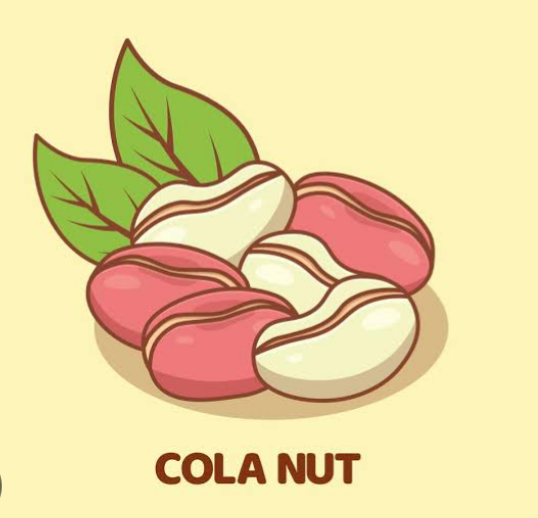
Kola nut contains caffeine which is a nitrogenous organic compound of the alkaloid group. It is a substances that have marked physiological effects. It is also found in tea, coffee, guarana, maté, and cacao.
Kola nut is a nut with two species : Cola acuminata and Cola nitida. It belongs to the member of the family Sterculiceae. It has a long history in West Africa but now also cultivated in the American tropics . Nigeria is reported to be the world largest producer of Kolanut, second to Nigeria is Cote d’Ivoire. In West Africa, Kola nut is intermediatly interwoven with the various culture of the people where it features in religious rights, social and ritual activities. It is used in marriages, child naming ceremony, funerals, and sacrifices. The frequency and variability of Cola nitida in the forest area of Cote d’Ivoire and Ghana are known for their center of origin. While Cola acuminata occur in Nigeria and Ghana as the center of origin. These two important commercial species were distributed by the activities of man.
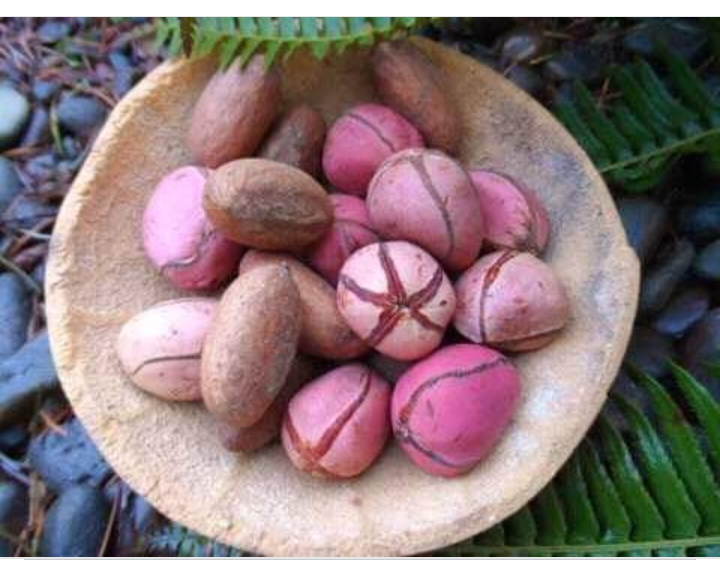
In other parts of the world, Kola nut varieties found include :Cola anomala in West Africa, Cola ballayi found in East Africa and Cola lepidota in Southeast Asia,
BENEFITS OF KOLA
1. Kola nut contains natural stimulants, including caffeine, theobromine, and kolanin. It has stimulating effect on the central nervous system, providing increased alertness and reducing fatigue
2. The Kola nut is ceremonially presented to guests as gesture of respect and as a means of initiating social interactions.
3. Its consumption has been associated with a temporary boost in energy levels and enhanced mental focus.
4. Kolanut is found to have potential medicinal properties, including antimicrobial, antioxidant, and anti-inflammatory effects.
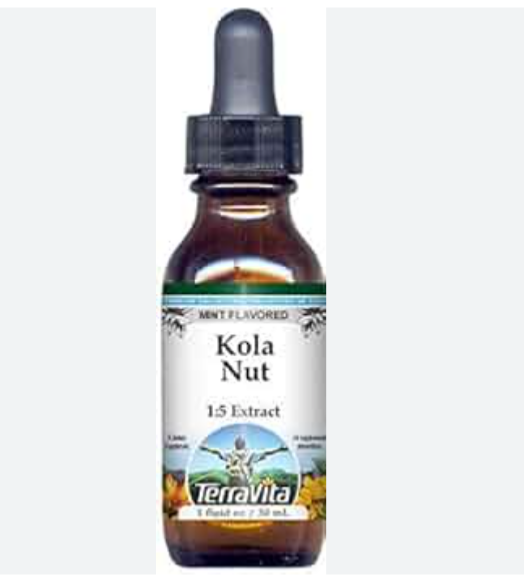
5. It has important uses in many ways. The most important uses is masticating agent due to their stimulating effect to suppress hunger, fatigue and sleep.
6. Some nuts are also used as source of die. 7. Industrially, it is used in the preparation of cola types of beverages like cola cola, Pepsi etc.
8. It is also used in making cola sweets, etc.
9. It is also a source of alkaloids ( caffeines and Theobroma in pharmaceutical industries).
10. The wood from its tree is used in calving, couch walk and boat building.
11. The tree back is used in treating swelling and fresh wounds.
12. The pod husk is used in some ingredients to reduce pain and the roots is an excellent chewing stick.
13. Small pieces of kola nut chewed before meals act as an aid to digestion.
14. In Brazil and the West Indies, the astringent-tasting nuts are used as a botanical drug to combat intoxication, hangover, and diarrhea.
15. Caffeine has a stimulating effect on the central nervous system, heart, blood vessels, and kidneys. It also acts as a mild diuretic.
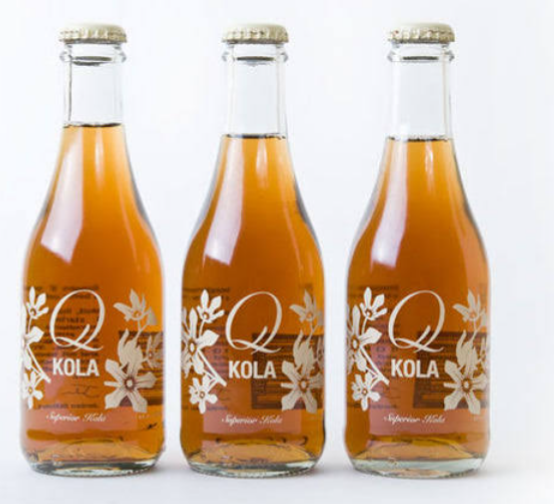
16. Caffeine’s potent stimulatory action makes it a valuable antidote to respiratory depression induced by drug overdose (e.g., from morphine or barbiturates).
17. The positive effects that have been described in people who use caffeine include improved motor performance, decreased fatigue, enhanced sensory activity, and increased alertness.
BOTANY:
a. THE TREE: Cola nitida tree is a robust tree, it is 9 to 12m tall. Atimes, it reaches height of 24m with the foliage not confined to the tip of the branches. While Cola acuminata is a slender tree usually 6 to 9m tall and can attain a height of 12m with a foliage usually confined to the tip of the branches.
b. THE FLOWERS: Both spp possess hermaphrodite flowers which are mixed with the seed inflorescence. But occasionally, may be separated or reoccur in different inflorescence or tree. The main flowering season last for 3 months producing 80 to 90% of the flowers and occurring from August to October with the peak in September. The proportion of the male hermaphrodite flower are influenced by time of flowering and it is 12 to 20% female hermaphrodite. The size of the nuts and fruits have being observed to be determined by the location of trees which is physiologically limited in nature.
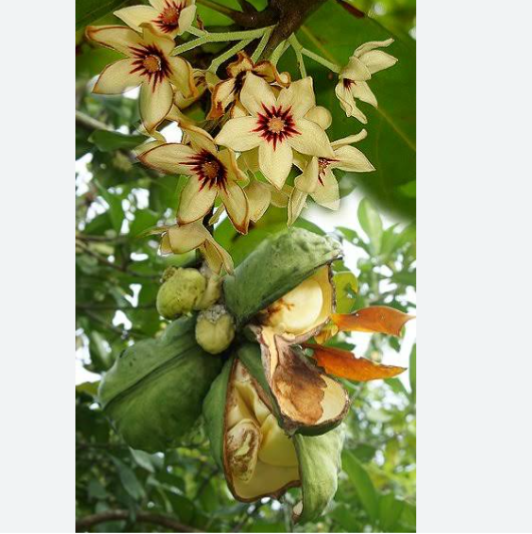
KOLA NUT SEED: The seeds of the Kola nut constitute the consumable portion of the fruit. The fruit has three layers:
i. The Exocarp: This is the outermost layer of the Kola nut fruit. It is typically thick and tough, providing a protective barrier against external elements.
ii. Mesocarp: Situated beneath the exocarp, the mesocarp forms a fibrous and succulent layer that serves to provide cushioning and protection for the inner seed(s) of the Kola nut.
iii. Endocarp: This is a durable and woody layer that encloses the seeds and functions as a sturdy shield. It reinforces and safeguarding the seeds.
CLIMATIC REQUIREMENT :
a. TEMPERATURE AND RAINFALL: Kola grows in tropical low land and in rainforest area with temperature around 25oC with a dianual range of up to 18oC. It occurs in areas of frost free night. Rainfall of 1250mm or more and in dry season of three or fewer month possessing precipitation of 50mm. The Kola nut tree is able to regulate within limits, it conserve water by partially shedding it’s leaves and just like cocoa which is well adapted to alternating wet and dry season.
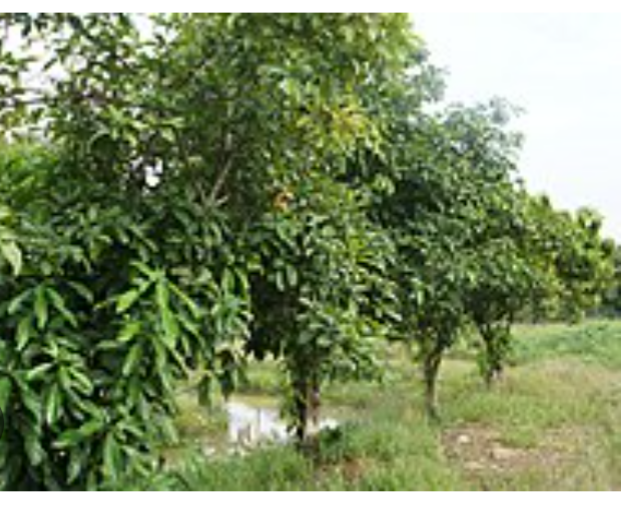
AGRONOMY:
a. SEED SELECTION FOR PROPAGATION: Farmers select healthy and mature Kola nut seeds for planting from ripe fruits that have fallen naturally from the tree to the ground. But it is adviseable to purchase Kola nut seeds from a reputable seed bank or nursery.
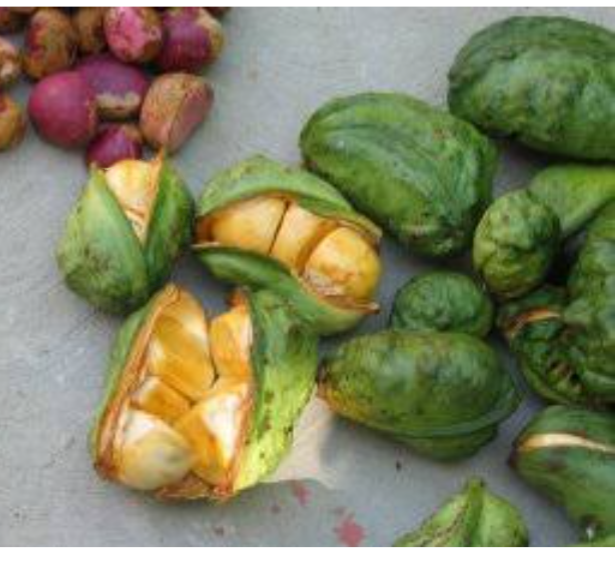
b. PROPAGATION: Plants can be propagated by seeds which are traditionally sown as stakes. However, seeds sown in nurseries perform better. Pre-germination of Kola nuts result in more rapid immergence than planting into nursery beds. Horizontally placed seeds usually result in a higher number of seedlings with straight roots. Seedlings to be planted must have bright green leaves free from spots or discoloration and the roots must not have any signs of rot. Seedlings should be provided with shades and much water inorder to develop within 5 months to the size required for successful transplanting. C. nitida takes 80 days to complete germination while C. acuminata takes 60 days to complete germination. Pregerminated seeds are planted in baskets or polythene bags filled with top soil at a depth of 7-10cm. Also, seedlings can be raised vegetatively from cuttings from 2 months old flushes.
c. CRITERIA FOR SELECTION OF MOTHER PLANTS
Some of the criteria used in selecting mother plants for seed or vegetative propagules include:
i. Size of tree
ii. Nut size
iii. Distribution of production over the years
iv. Occurrence of alternate bearing etc
CUTTINGS AND IT’S PREPARATION FOR PLANTING: Cuttings are made in the morning or late in the day. Cuttings should be 15-20cm long without including the base of the flush. Cuttings are then cut under water with shape knife and placed obliguely in rooting medium. Then planting and watering immediately follows. Watering should be done thrice daily using sprayers like knapsack sprayer until a fume of water apper on the leaves. At approximately 9 weeks after setting, roots start to develop from callous tissues at the base of the flush. The rooted cuttings are then potted in rigid containers at least 40cm high to provide sufficient space for new roots and then placed in the propagator for 3 weeks to hardened. From there, they are transfered to the nursery.
LAND PREPARATION : In Kola cultivation, there are three types of land clearing, which include clear felling, selective thinning and simple felling. Each of these methods influences growth habits of Kola seedlings and rammets. Clear felling exposes the seedlings which result in compact habit (that is short/dwarf habit), short internode, frequent branching, leaves spot and die back of twigs often with attack from fungal disease. Shelter trees on the other hand from selective thinned forest have etiolated appearances ( internal elongation due to light shedding).
Simple felling and a temporary regrowth of vegetation along traces gives the best result of seedlings.
SOIL REQUIREMENT : As a tap root tree, it requires a deep, well drained soil, more tolerance of less favourable soil or lighter soil and also survive in less fertile soils than other trees crops like cocoa. But it will respond well to fertile soils rich in organic matter content. Loamy soil with a pH between 6.0 and 7.5 is ideal for growing Kola. If the soil is too acidic, lime or sulfur can be added.
SPACING: The average canopy diameter of a mature tree in Nigeria is 8m. Therefore, suggested spacing for mature trees is 7.5m by 9m depending on the site fertility. Interplanting of extra seedlings can be done half way between stands. That is, between rows and diagonal at a spacing of 3.75 to 4.5m for seedlings which could be thinned by the 10th year while closer spacing of 2.5 by 3m can be used for rammets which could be thinned at the 6th year after planting. Closer spacing ensures higher yield per hectare during the early productive year of the crop and this should be followed by timely reduction in the number of trees to allow for development of the stands.
PLANTING OPERATION:
a. TIME OF PLANTING : A suitable planting time in Southwest Nigeria or polar region is April in early rain. But at norther polar belt, it is May. Any plant established very late in rainy season often die during the sebsequent early rain.
b. OVERHEAD SHADE REQUIREMENT : Shaded seedlings experience increase diameter to approximately four times that of unshadded plants. A plant under light shade (33% shading) perform better than 66% shading. While a dense shading reduces the relative development of seedlings. Kola trees are mostly planted in forest areas where the forest trees can provide overhead shade for the young polar plants. Sometimes, northern parts of polar belt that has a covering of savanna trees whose canopies are touching, with light distributed shades can be chosen for the cultivation and production of Kola trees.
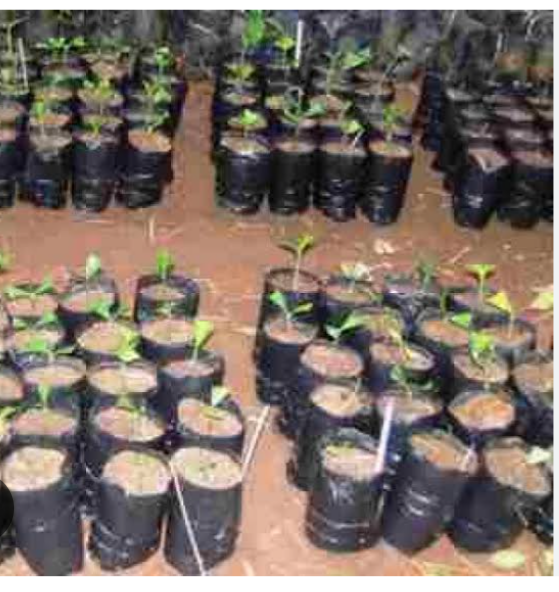
TRANSPLANTING OF SEEDLING: Early rain support successful transplanting of Kola seedlings. At transplanting, seedlings should be 40-50 cm high and 12-14 expanded leaves (5 to 6th month of growth) at which stage, the roots would have possessed 1/5th – 1/4th of the total dry matter of the seedling. Plants with lesser quality usually dieback or remain stunted. After transplanting, 4-6 month old seedlings will still retain turgid cotyledon which may contain reserved food for seedling and help the plant to endure transplanting shock. When transplanting from beds, naked root method is used. Using a furrow across the bed and use a garden fork or hand trowel to loosen the soil. Cut the tap root underneath the furrow. This method ensures that no damage is done to the root. At the time of transplanting, the cotyledon should be at thasame level with the surrounding soil surface. Shade should be supplied to the seedling using 2-4 palm fronds tied to the top of the seedlings. Water should be applied regularly.
POST PLANTING MAINTENANCE
a. SHADING AND WEEDING: During early years of Kola growth, food crops are Intercropped between trees. After this when crops mature, and annual crops are no more cultivated, it is important to maintain a clean plantation by slashing of weeds. This is done twice a year. Cleared land ensures that the farmer can spot fallen fruits.
b. SHADDING: When trees are young in the early years (2years of growth), and the Kola tree is established under thin forest, the shade trees are ringed back so that the tree would die back slowly thus, reducing shade end ensuring fruit development and productivity.
c. MULCHING: Mulching is done weeks ahead of unset of dry season especially for young seedling using herbaceous materials especially banana leaves as decaying wood may serve as substitute to root diseases such as romes naxin. The mulch should be applied in a ring covering the area between 15-100cm from the trunk to allow air and prevent occurrence of fungal diseases. Other maintenance operations include : fertilizer application, sanitation, rejuvenation and regeneration.
FERTILIZER APPLICATION : The soil should be enrich with organic matter like compost or aged manure to improve nutrient content and water retention capacity. Some of the nutrients required in the fertilizers include:
Nitrogen: It encourage lush foliage growth. Nitrogen-rich fertilizer like blood meal or fish emulsion can be used.
Phosphorus: Promote root development and flowering. Bone meal or rock phosphate can be used.
Potassium: Support overall plant health and water balance. Green manures or potassium sulfate can be applied.
The three primary nutrients are needed for kola nut plants to thrive.
Organic options like compost or well-rotted manure mixed into the soil around each tree at planting time or top dressing during growing season will provide all necessary elements needed by Kolanuts trees without harming the environment or posing any health risks associated with synthetic chemicals used in conventional agriculture practices.
HARVESTING
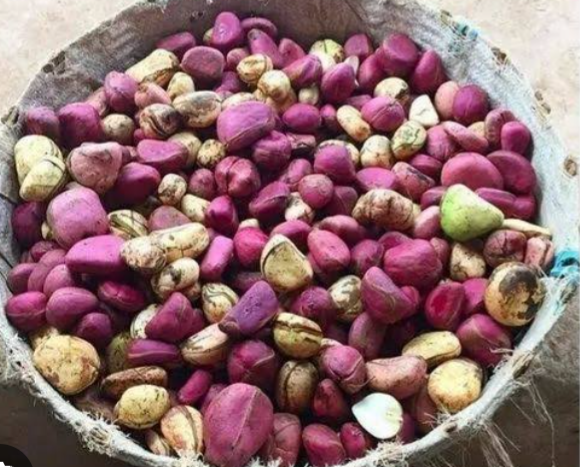
Kola nut trees typically start bearing fruit after 5-7 years. The fruits are harvested when they turn yellow or reddish-brown and begin to split open naturally. Harvesting is done by hand, and the collected fruits are dried in the sun or in well-ventilated spaces to remove excess moisture.

